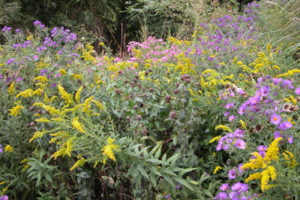Vol. 16 Issue 2, Summer 2011
By Donna Quinn
Excerpted from bringingnaturehome.net/native-gardening/gardening-for-life
Sobering Facts:
The Chesapeake Bay Watershed has lost 100 acres of forest each day since 1985.
In the continental United States:
- There are 4 million miles of paved roads — paving 5 times the size of New Jersey.
- There are over 62,500 square miles of lawn (40 million acres) — 8 times the size of New Jersey.
- We have taken 95% of nature and made it unnatural. Studies have shown that species are lost at the same proportion with which a habitat is reduced in size, so we can expect to lose 95% of all native plant and animal species as a consequence.
Losing 95% of plant and animal species is not just sad — it is life threatening. We need biodiversity! Humans cannot live as the only species on this planet because it is other species that create the ecosystem and services essential to us. It is biodiversity that generates oxygen and clean water; that creates topsoil out of rock and buffers extreme weather events like droughts and floods; and that recycles the mountains of garbage we create every day. And now, with human-induced climate change threatening the planet, it is biodiversity that will help to suck that excess carbon out of the air and sequester it in living plants if given half a chance.
What We Can Do:

Photo by Nicole Hamilton
Plant native plants — and lots of them! There is valid scientific reasoning for this, deduced from thousands of studies about how energy moves through food webs. Here is the general reasoning: All animals get their energy from plants, either by directly eating them or by eating something that has already eaten a plant. The group of animals most responsible for passing energy from plants to the animals that can’t directly eat plants is insects. Thus insects are vital components of healthy ecosystems. So many animals depend on insects for food (e.g., spiders, reptiles and amphibians, rodents, most birds) that removing insects from an ecosystem spells its doom.
Why native plants? With few exceptions, only insect species that have shared a long evolutionary history with a particular plant lineage have developed the physiological adaptations required to digest the chemicals in their host’s leaves. They have specialized over time to eat only the plants sharing those particular chemicals. When we present local insects with plants that evolved on another continent, chances are our insects will be unable to eat them. We used to think this was good. Kill all insects before they eat our plants! But an insect that cannot eat part of a leaf cannot fulfill its role in the food web. While exotics and hybrids may look pretty in our gardens, they may as well be made of plastic to insects and animals that depend on their native plant companions for habitat, food, and reproduction. As gardeners and stewards of our land, the need to save biodiversity from extinction has never been greater, nor have we have been so empowered to do so. What can each one of us do? Plant native plants!

